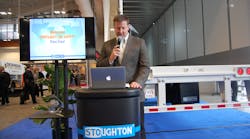NASHVILLE. Stoughton Trailers is planning to introduce a refrigerated trailer by the end of this year, with full production to start in early 2018, according to Bob Wahlin, the company’s president and CEO.
“This is a traditionally-designed reefer and we’ve built a little over 100 to date for validation testing,” he explained to Fleet Owner here during a press conference at the 2017 Technology & Maintenance Council (TMC) annual meeting.
“We’ve largely completed our testing and we’ll be ready to roll with full production in early 2018,” Wahlin added. “We’re setting up to build 3,000 to 5,000 a year.”
Stoughton executives noted that the floor rating for its new reefer trailer will be around 16,000 lbs. and expect to begin taking orders in the fourth quarter this year.
The company also added a highly emotional element to its press event, inviting Marianne Karth to speak. Karth lost two of her nine children – 13- and 17-year-old daughters Mary Lydia and AnnaLeah – in a 2013 collision with a trailer underride guard. Since that time, Karth and her husband have worked tirelessly to upgrade trailer underride guard standards – something Stoughton did voluntarily on its own, introducing its beefed-up design at a crash test event hosted by the Insurance Institute for Highway Safety (IIHS) last May.
Stoughton said at its TMC press conference that its newly designed rear impact guard provides underride protection over the full width of the rear end of a trailer, without added weight and at no additional cost. The company stressed that this new underride design is now a standard feature on all Stoughton dry van trailers and is being made available as a retrofit kit, though those kits do add weight and some extra cost to older Stoughton dry van models, the OEM noted.
The company also said it’s made some other upgrades to its Z-Plate and aluminum sheet & post dry van units for 2017:
- A new top rail design allows for the side-wall sheet to extend up behind the lower portion of the top rail to improve water shedding. Eliminating drilling holes in the top rail adds to the unit’s overall “water tightness.”
- New roof bows are now connected using a T-Bolt & Slot design. This allows replacement roof bows to be installed entirely on the inside of the trailer, reducing installation time and the need for exterior scaffolding.
- Dry van corner posts and top corner castings are now common corner components, allowing them to be interchangeable between Z-Plate and aluminum sheet & post models, reducing the number of parts needed for trailer repair.
- That new corner design increases the sheet & post corner panel to 0.125 inches from its original .050-inch thickness. That new corner post also creates a square interior corner, allowing full-width cargo placement to extend to the front lining.
- A new Z-Plate lower rail design means the lower rail is now 3.5 inches taller, allowing rivets to be placed 3.5 inches higher. Moving the rivets away from the scrape zone improves durability, the company said.
- The side rail and scuff liner on Stoughton’s aluminum sheet and post trailers is now a full 12 inches high to further prevents damage from loading and unloading, with no exposed attachments that loads can snag or tear out.



